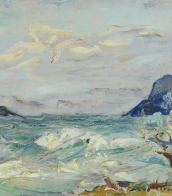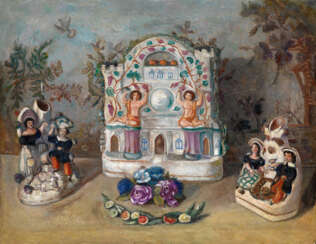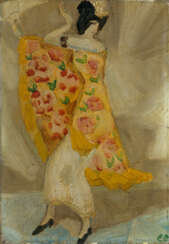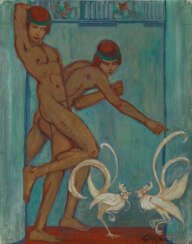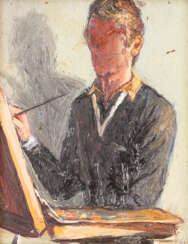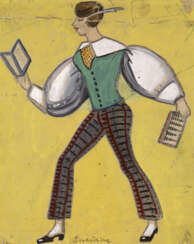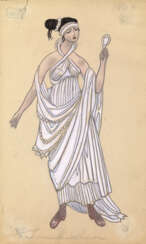sergei jurjewitsch sudeikin (1882 - 1946)
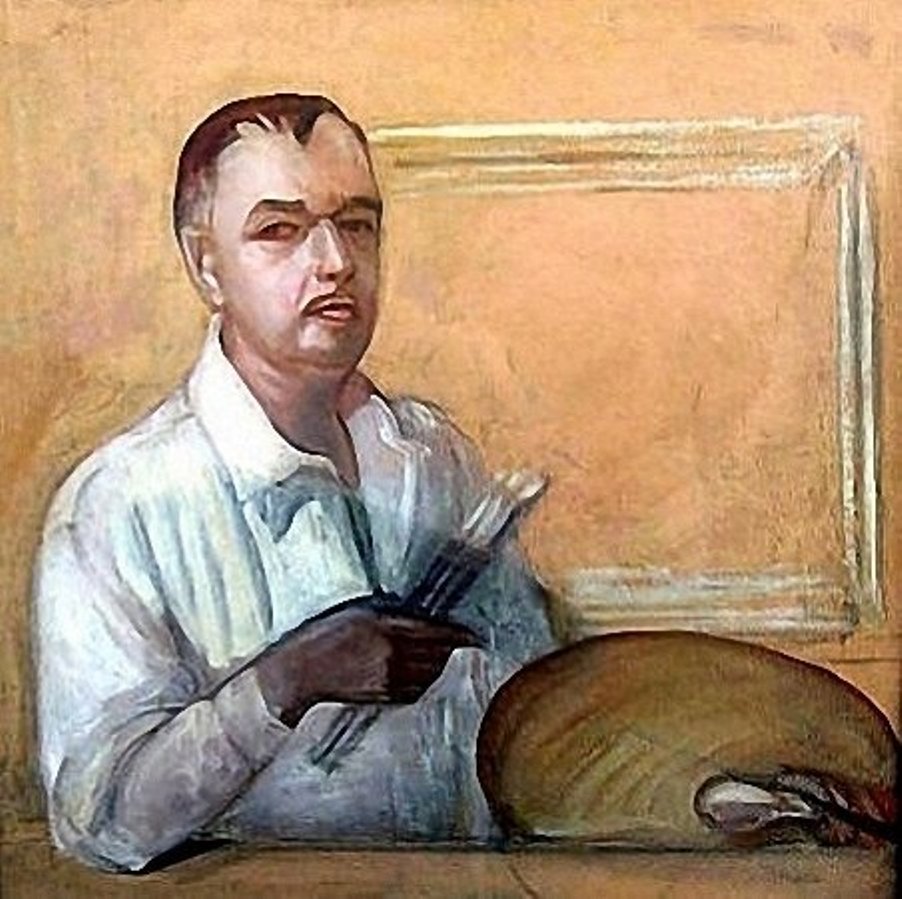
Sergey Yurievich Sudeikin (Russian: Сергей Юрьевич Судейкин), also known as Serge Soudeikine, was a Russian artist and set-designer renowned for his vivid contributions to the world of art and theater. Born on March 19, 1882, in Smolensk, Russia, and passing away on August 12, 1946, in Nyack, New York, Sudeikin's career was a testament to his versatile talent and innovative vision. He was closely associated with prestigious institutions such as the Ballets Russes and the Metropolitan Opera, showcasing his unique ability to blend artistic and theatrical design.
Sudeikin's journey in the arts began at the Moscow School of Painting, Sculpture and Architecture, where he was notably banned for his bold, "obscene drawings". This rebellious start led him to join the Mir Iskusstva (World of Art) movement, solidifying his place among Russia's avant-garde artists. His circle included significant figures like poet Mikhail Kuzmin and impresario Serge Diaghilev, highlighting his integral role in Russia's cultural scene before emigrating to the West.
Among Sudeikin's notable works are his set and costume designs for Diaghilev's production of "La tragédie de Salomé" and his collaboration on "The Rite of Spring". After moving to the United States, he continued to leave his mark on the theater world, with works like the set design for the original Broadway production of "Porgy and Bess". Sudeikin's style is recognized for its theatricality, vivid color use, and often incorporated themes of irony and tragedy, deeply influencing the visual arts and theater design of the 20th century.
His artwork, including famous pieces like "Carousel", "Venetian masquerade", and "Portrait of Nina Shik", can be found in galleries and private collections worldwide, highlighting his enduring appeal. Despite facing challenges in gaining widespread recognition during his lifetime, Sudeikin's contributions to art and theater have solidified his legacy as a pioneering artist and designer.
Collectors and experts in art and antiques continue to celebrate Sergey Yurievich Sudeikin's work for its innovative approach and historical significance. To stay updated on sales and auction events related to Sudeikin's work, signing up for updates is highly recommended. This ensures that enthusiasts and collectors alike do not miss out on the opportunity to own a piece of this remarkable artist's legacy.


Sergey Yurievich Sudeikin (Russian: Сергей Юрьевич Судейкин), also known as Serge Soudeikine, was a Russian artist and set-designer renowned for his vivid contributions to the world of art and theater. Born on March 19, 1882, in Smolensk, Russia, and passing away on August 12, 1946, in Nyack, New York, Sudeikin's career was a testament to his versatile talent and innovative vision. He was closely associated with prestigious institutions such as the Ballets Russes and the Metropolitan Opera, showcasing his unique ability to blend artistic and theatrical design.
Sudeikin's journey in the arts began at the Moscow School of Painting, Sculpture and Architecture, where he was notably banned for his bold, "obscene drawings". This rebellious start led him to join the Mir Iskusstva (World of Art) movement, solidifying his place among Russia's avant-garde artists. His circle included significant figures like poet Mikhail Kuzmin and impresario Serge Diaghilev, highlighting his integral role in Russia's cultural scene before emigrating to the West.
Among Sudeikin's notable works are his set and costume designs for Diaghilev's production of "La tragédie de Salomé" and his collaboration on "The Rite of Spring". After moving to the United States, he continued to leave his mark on the theater world, with works like the set design for the original Broadway production of "Porgy and Bess". Sudeikin's style is recognized for its theatricality, vivid color use, and often incorporated themes of irony and tragedy, deeply influencing the visual arts and theater design of the 20th century.
His artwork, including famous pieces like "Carousel", "Venetian masquerade", and "Portrait of Nina Shik", can be found in galleries and private collections worldwide, highlighting his enduring appeal. Despite facing challenges in gaining widespread recognition during his lifetime, Sudeikin's contributions to art and theater have solidified his legacy as a pioneering artist and designer.
Collectors and experts in art and antiques continue to celebrate Sergey Yurievich Sudeikin's work for its innovative approach and historical significance. To stay updated on sales and auction events related to Sudeikin's work, signing up for updates is highly recommended. This ensures that enthusiasts and collectors alike do not miss out on the opportunity to own a piece of this remarkable artist's legacy.


Sergey Yurievich Sudeikin (Russian: Сергей Юрьевич Судейкин), also known as Serge Soudeikine, was a Russian artist and set-designer renowned for his vivid contributions to the world of art and theater. Born on March 19, 1882, in Smolensk, Russia, and passing away on August 12, 1946, in Nyack, New York, Sudeikin's career was a testament to his versatile talent and innovative vision. He was closely associated with prestigious institutions such as the Ballets Russes and the Metropolitan Opera, showcasing his unique ability to blend artistic and theatrical design.
Sudeikin's journey in the arts began at the Moscow School of Painting, Sculpture and Architecture, where he was notably banned for his bold, "obscene drawings". This rebellious start led him to join the Mir Iskusstva (World of Art) movement, solidifying his place among Russia's avant-garde artists. His circle included significant figures like poet Mikhail Kuzmin and impresario Serge Diaghilev, highlighting his integral role in Russia's cultural scene before emigrating to the West.
Among Sudeikin's notable works are his set and costume designs for Diaghilev's production of "La tragédie de Salomé" and his collaboration on "The Rite of Spring". After moving to the United States, he continued to leave his mark on the theater world, with works like the set design for the original Broadway production of "Porgy and Bess". Sudeikin's style is recognized for its theatricality, vivid color use, and often incorporated themes of irony and tragedy, deeply influencing the visual arts and theater design of the 20th century.
His artwork, including famous pieces like "Carousel", "Venetian masquerade", and "Portrait of Nina Shik", can be found in galleries and private collections worldwide, highlighting his enduring appeal. Despite facing challenges in gaining widespread recognition during his lifetime, Sudeikin's contributions to art and theater have solidified his legacy as a pioneering artist and designer.
Collectors and experts in art and antiques continue to celebrate Sergey Yurievich Sudeikin's work for its innovative approach and historical significance. To stay updated on sales and auction events related to Sudeikin's work, signing up for updates is highly recommended. This ensures that enthusiasts and collectors alike do not miss out on the opportunity to own a piece of this remarkable artist's legacy.
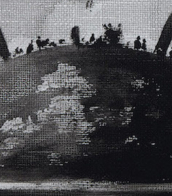

Sergey Yurievich Sudeikin (Russian: Сергей Юрьевич Судейкин), also known as Serge Soudeikine, was a Russian artist and set-designer renowned for his vivid contributions to the world of art and theater. Born on March 19, 1882, in Smolensk, Russia, and passing away on August 12, 1946, in Nyack, New York, Sudeikin's career was a testament to his versatile talent and innovative vision. He was closely associated with prestigious institutions such as the Ballets Russes and the Metropolitan Opera, showcasing his unique ability to blend artistic and theatrical design.
Sudeikin's journey in the arts began at the Moscow School of Painting, Sculpture and Architecture, where he was notably banned for his bold, "obscene drawings". This rebellious start led him to join the Mir Iskusstva (World of Art) movement, solidifying his place among Russia's avant-garde artists. His circle included significant figures like poet Mikhail Kuzmin and impresario Serge Diaghilev, highlighting his integral role in Russia's cultural scene before emigrating to the West.
Among Sudeikin's notable works are his set and costume designs for Diaghilev's production of "La tragédie de Salomé" and his collaboration on "The Rite of Spring". After moving to the United States, he continued to leave his mark on the theater world, with works like the set design for the original Broadway production of "Porgy and Bess". Sudeikin's style is recognized for its theatricality, vivid color use, and often incorporated themes of irony and tragedy, deeply influencing the visual arts and theater design of the 20th century.
His artwork, including famous pieces like "Carousel", "Venetian masquerade", and "Portrait of Nina Shik", can be found in galleries and private collections worldwide, highlighting his enduring appeal. Despite facing challenges in gaining widespread recognition during his lifetime, Sudeikin's contributions to art and theater have solidified his legacy as a pioneering artist and designer.
Collectors and experts in art and antiques continue to celebrate Sergey Yurievich Sudeikin's work for its innovative approach and historical significance. To stay updated on sales and auction events related to Sudeikin's work, signing up for updates is highly recommended. This ensures that enthusiasts and collectors alike do not miss out on the opportunity to own a piece of this remarkable artist's legacy.
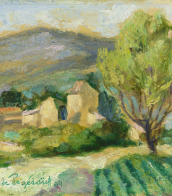

Sergey Yurievich Sudeikin (Russian: Сергей Юрьевич Судейкин), also known as Serge Soudeikine, was a Russian artist and set-designer renowned for his vivid contributions to the world of art and theater. Born on March 19, 1882, in Smolensk, Russia, and passing away on August 12, 1946, in Nyack, New York, Sudeikin's career was a testament to his versatile talent and innovative vision. He was closely associated with prestigious institutions such as the Ballets Russes and the Metropolitan Opera, showcasing his unique ability to blend artistic and theatrical design.
Sudeikin's journey in the arts began at the Moscow School of Painting, Sculpture and Architecture, where he was notably banned for his bold, "obscene drawings". This rebellious start led him to join the Mir Iskusstva (World of Art) movement, solidifying his place among Russia's avant-garde artists. His circle included significant figures like poet Mikhail Kuzmin and impresario Serge Diaghilev, highlighting his integral role in Russia's cultural scene before emigrating to the West.
Among Sudeikin's notable works are his set and costume designs for Diaghilev's production of "La tragédie de Salomé" and his collaboration on "The Rite of Spring". After moving to the United States, he continued to leave his mark on the theater world, with works like the set design for the original Broadway production of "Porgy and Bess". Sudeikin's style is recognized for its theatricality, vivid color use, and often incorporated themes of irony and tragedy, deeply influencing the visual arts and theater design of the 20th century.
His artwork, including famous pieces like "Carousel", "Venetian masquerade", and "Portrait of Nina Shik", can be found in galleries and private collections worldwide, highlighting his enduring appeal. Despite facing challenges in gaining widespread recognition during his lifetime, Sudeikin's contributions to art and theater have solidified his legacy as a pioneering artist and designer.
Collectors and experts in art and antiques continue to celebrate Sergey Yurievich Sudeikin's work for its innovative approach and historical significance. To stay updated on sales and auction events related to Sudeikin's work, signing up for updates is highly recommended. This ensures that enthusiasts and collectors alike do not miss out on the opportunity to own a piece of this remarkable artist's legacy.


Sergey Yurievich Sudeikin (Russian: Сергей Юрьевич Судейкин), also known as Serge Soudeikine, was a Russian artist and set-designer renowned for his vivid contributions to the world of art and theater. Born on March 19, 1882, in Smolensk, Russia, and passing away on August 12, 1946, in Nyack, New York, Sudeikin's career was a testament to his versatile talent and innovative vision. He was closely associated with prestigious institutions such as the Ballets Russes and the Metropolitan Opera, showcasing his unique ability to blend artistic and theatrical design.
Sudeikin's journey in the arts began at the Moscow School of Painting, Sculpture and Architecture, where he was notably banned for his bold, "obscene drawings". This rebellious start led him to join the Mir Iskusstva (World of Art) movement, solidifying his place among Russia's avant-garde artists. His circle included significant figures like poet Mikhail Kuzmin and impresario Serge Diaghilev, highlighting his integral role in Russia's cultural scene before emigrating to the West.
Among Sudeikin's notable works are his set and costume designs for Diaghilev's production of "La tragédie de Salomé" and his collaboration on "The Rite of Spring". After moving to the United States, he continued to leave his mark on the theater world, with works like the set design for the original Broadway production of "Porgy and Bess". Sudeikin's style is recognized for its theatricality, vivid color use, and often incorporated themes of irony and tragedy, deeply influencing the visual arts and theater design of the 20th century.
His artwork, including famous pieces like "Carousel", "Venetian masquerade", and "Portrait of Nina Shik", can be found in galleries and private collections worldwide, highlighting his enduring appeal. Despite facing challenges in gaining widespread recognition during his lifetime, Sudeikin's contributions to art and theater have solidified his legacy as a pioneering artist and designer.
Collectors and experts in art and antiques continue to celebrate Sergey Yurievich Sudeikin's work for its innovative approach and historical significance. To stay updated on sales and auction events related to Sudeikin's work, signing up for updates is highly recommended. This ensures that enthusiasts and collectors alike do not miss out on the opportunity to own a piece of this remarkable artist's legacy.


Sergey Yurievich Sudeikin (Russian: Сергей Юрьевич Судейкин), also known as Serge Soudeikine, was a Russian artist and set-designer renowned for his vivid contributions to the world of art and theater. Born on March 19, 1882, in Smolensk, Russia, and passing away on August 12, 1946, in Nyack, New York, Sudeikin's career was a testament to his versatile talent and innovative vision. He was closely associated with prestigious institutions such as the Ballets Russes and the Metropolitan Opera, showcasing his unique ability to blend artistic and theatrical design.
Sudeikin's journey in the arts began at the Moscow School of Painting, Sculpture and Architecture, where he was notably banned for his bold, "obscene drawings". This rebellious start led him to join the Mir Iskusstva (World of Art) movement, solidifying his place among Russia's avant-garde artists. His circle included significant figures like poet Mikhail Kuzmin and impresario Serge Diaghilev, highlighting his integral role in Russia's cultural scene before emigrating to the West.
Among Sudeikin's notable works are his set and costume designs for Diaghilev's production of "La tragédie de Salomé" and his collaboration on "The Rite of Spring". After moving to the United States, he continued to leave his mark on the theater world, with works like the set design for the original Broadway production of "Porgy and Bess". Sudeikin's style is recognized for its theatricality, vivid color use, and often incorporated themes of irony and tragedy, deeply influencing the visual arts and theater design of the 20th century.
His artwork, including famous pieces like "Carousel", "Venetian masquerade", and "Portrait of Nina Shik", can be found in galleries and private collections worldwide, highlighting his enduring appeal. Despite facing challenges in gaining widespread recognition during his lifetime, Sudeikin's contributions to art and theater have solidified his legacy as a pioneering artist and designer.
Collectors and experts in art and antiques continue to celebrate Sergey Yurievich Sudeikin's work for its innovative approach and historical significance. To stay updated on sales and auction events related to Sudeikin's work, signing up for updates is highly recommended. This ensures that enthusiasts and collectors alike do not miss out on the opportunity to own a piece of this remarkable artist's legacy.


Sergey Yurievich Sudeikin (Russian: Сергей Юрьевич Судейкин), also known as Serge Soudeikine, was a Russian artist and set-designer renowned for his vivid contributions to the world of art and theater. Born on March 19, 1882, in Smolensk, Russia, and passing away on August 12, 1946, in Nyack, New York, Sudeikin's career was a testament to his versatile talent and innovative vision. He was closely associated with prestigious institutions such as the Ballets Russes and the Metropolitan Opera, showcasing his unique ability to blend artistic and theatrical design.
Sudeikin's journey in the arts began at the Moscow School of Painting, Sculpture and Architecture, where he was notably banned for his bold, "obscene drawings". This rebellious start led him to join the Mir Iskusstva (World of Art) movement, solidifying his place among Russia's avant-garde artists. His circle included significant figures like poet Mikhail Kuzmin and impresario Serge Diaghilev, highlighting his integral role in Russia's cultural scene before emigrating to the West.
Among Sudeikin's notable works are his set and costume designs for Diaghilev's production of "La tragédie de Salomé" and his collaboration on "The Rite of Spring". After moving to the United States, he continued to leave his mark on the theater world, with works like the set design for the original Broadway production of "Porgy and Bess". Sudeikin's style is recognized for its theatricality, vivid color use, and often incorporated themes of irony and tragedy, deeply influencing the visual arts and theater design of the 20th century.
His artwork, including famous pieces like "Carousel", "Venetian masquerade", and "Portrait of Nina Shik", can be found in galleries and private collections worldwide, highlighting his enduring appeal. Despite facing challenges in gaining widespread recognition during his lifetime, Sudeikin's contributions to art and theater have solidified his legacy as a pioneering artist and designer.
Collectors and experts in art and antiques continue to celebrate Sergey Yurievich Sudeikin's work for its innovative approach and historical significance. To stay updated on sales and auction events related to Sudeikin's work, signing up for updates is highly recommended. This ensures that enthusiasts and collectors alike do not miss out on the opportunity to own a piece of this remarkable artist's legacy.


Sergey Yurievich Sudeikin (Russian: Сергей Юрьевич Судейкин), also known as Serge Soudeikine, was a Russian artist and set-designer renowned for his vivid contributions to the world of art and theater. Born on March 19, 1882, in Smolensk, Russia, and passing away on August 12, 1946, in Nyack, New York, Sudeikin's career was a testament to his versatile talent and innovative vision. He was closely associated with prestigious institutions such as the Ballets Russes and the Metropolitan Opera, showcasing his unique ability to blend artistic and theatrical design.
Sudeikin's journey in the arts began at the Moscow School of Painting, Sculpture and Architecture, where he was notably banned for his bold, "obscene drawings". This rebellious start led him to join the Mir Iskusstva (World of Art) movement, solidifying his place among Russia's avant-garde artists. His circle included significant figures like poet Mikhail Kuzmin and impresario Serge Diaghilev, highlighting his integral role in Russia's cultural scene before emigrating to the West.
Among Sudeikin's notable works are his set and costume designs for Diaghilev's production of "La tragédie de Salomé" and his collaboration on "The Rite of Spring". After moving to the United States, he continued to leave his mark on the theater world, with works like the set design for the original Broadway production of "Porgy and Bess". Sudeikin's style is recognized for its theatricality, vivid color use, and often incorporated themes of irony and tragedy, deeply influencing the visual arts and theater design of the 20th century.
His artwork, including famous pieces like "Carousel", "Venetian masquerade", and "Portrait of Nina Shik", can be found in galleries and private collections worldwide, highlighting his enduring appeal. Despite facing challenges in gaining widespread recognition during his lifetime, Sudeikin's contributions to art and theater have solidified his legacy as a pioneering artist and designer.
Collectors and experts in art and antiques continue to celebrate Sergey Yurievich Sudeikin's work for its innovative approach and historical significance. To stay updated on sales and auction events related to Sudeikin's work, signing up for updates is highly recommended. This ensures that enthusiasts and collectors alike do not miss out on the opportunity to own a piece of this remarkable artist's legacy.


Sergey Yurievich Sudeikin (Russian: Сергей Юрьевич Судейкин), also known as Serge Soudeikine, was a Russian artist and set-designer renowned for his vivid contributions to the world of art and theater. Born on March 19, 1882, in Smolensk, Russia, and passing away on August 12, 1946, in Nyack, New York, Sudeikin's career was a testament to his versatile talent and innovative vision. He was closely associated with prestigious institutions such as the Ballets Russes and the Metropolitan Opera, showcasing his unique ability to blend artistic and theatrical design.
Sudeikin's journey in the arts began at the Moscow School of Painting, Sculpture and Architecture, where he was notably banned for his bold, "obscene drawings". This rebellious start led him to join the Mir Iskusstva (World of Art) movement, solidifying his place among Russia's avant-garde artists. His circle included significant figures like poet Mikhail Kuzmin and impresario Serge Diaghilev, highlighting his integral role in Russia's cultural scene before emigrating to the West.
Among Sudeikin's notable works are his set and costume designs for Diaghilev's production of "La tragédie de Salomé" and his collaboration on "The Rite of Spring". After moving to the United States, he continued to leave his mark on the theater world, with works like the set design for the original Broadway production of "Porgy and Bess". Sudeikin's style is recognized for its theatricality, vivid color use, and often incorporated themes of irony and tragedy, deeply influencing the visual arts and theater design of the 20th century.
His artwork, including famous pieces like "Carousel", "Venetian masquerade", and "Portrait of Nina Shik", can be found in galleries and private collections worldwide, highlighting his enduring appeal. Despite facing challenges in gaining widespread recognition during his lifetime, Sudeikin's contributions to art and theater have solidified his legacy as a pioneering artist and designer.
Collectors and experts in art and antiques continue to celebrate Sergey Yurievich Sudeikin's work for its innovative approach and historical significance. To stay updated on sales and auction events related to Sudeikin's work, signing up for updates is highly recommended. This ensures that enthusiasts and collectors alike do not miss out on the opportunity to own a piece of this remarkable artist's legacy.
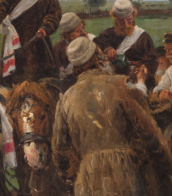

Sergey Yurievich Sudeikin (Russian: Сергей Юрьевич Судейкин), also known as Serge Soudeikine, was a Russian artist and set-designer renowned for his vivid contributions to the world of art and theater. Born on March 19, 1882, in Smolensk, Russia, and passing away on August 12, 1946, in Nyack, New York, Sudeikin's career was a testament to his versatile talent and innovative vision. He was closely associated with prestigious institutions such as the Ballets Russes and the Metropolitan Opera, showcasing his unique ability to blend artistic and theatrical design.
Sudeikin's journey in the arts began at the Moscow School of Painting, Sculpture and Architecture, where he was notably banned for his bold, "obscene drawings". This rebellious start led him to join the Mir Iskusstva (World of Art) movement, solidifying his place among Russia's avant-garde artists. His circle included significant figures like poet Mikhail Kuzmin and impresario Serge Diaghilev, highlighting his integral role in Russia's cultural scene before emigrating to the West.
Among Sudeikin's notable works are his set and costume designs for Diaghilev's production of "La tragédie de Salomé" and his collaboration on "The Rite of Spring". After moving to the United States, he continued to leave his mark on the theater world, with works like the set design for the original Broadway production of "Porgy and Bess". Sudeikin's style is recognized for its theatricality, vivid color use, and often incorporated themes of irony and tragedy, deeply influencing the visual arts and theater design of the 20th century.
His artwork, including famous pieces like "Carousel", "Venetian masquerade", and "Portrait of Nina Shik", can be found in galleries and private collections worldwide, highlighting his enduring appeal. Despite facing challenges in gaining widespread recognition during his lifetime, Sudeikin's contributions to art and theater have solidified his legacy as a pioneering artist and designer.
Collectors and experts in art and antiques continue to celebrate Sergey Yurievich Sudeikin's work for its innovative approach and historical significance. To stay updated on sales and auction events related to Sudeikin's work, signing up for updates is highly recommended. This ensures that enthusiasts and collectors alike do not miss out on the opportunity to own a piece of this remarkable artist's legacy.

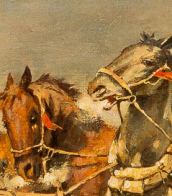

Sergey Yurievich Sudeikin (Russian: Сергей Юрьевич Судейкин), also known as Serge Soudeikine, was a Russian artist and set-designer renowned for his vivid contributions to the world of art and theater. Born on March 19, 1882, in Smolensk, Russia, and passing away on August 12, 1946, in Nyack, New York, Sudeikin's career was a testament to his versatile talent and innovative vision. He was closely associated with prestigious institutions such as the Ballets Russes and the Metropolitan Opera, showcasing his unique ability to blend artistic and theatrical design.
Sudeikin's journey in the arts began at the Moscow School of Painting, Sculpture and Architecture, where he was notably banned for his bold, "obscene drawings". This rebellious start led him to join the Mir Iskusstva (World of Art) movement, solidifying his place among Russia's avant-garde artists. His circle included significant figures like poet Mikhail Kuzmin and impresario Serge Diaghilev, highlighting his integral role in Russia's cultural scene before emigrating to the West.
Among Sudeikin's notable works are his set and costume designs for Diaghilev's production of "La tragédie de Salomé" and his collaboration on "The Rite of Spring". After moving to the United States, he continued to leave his mark on the theater world, with works like the set design for the original Broadway production of "Porgy and Bess". Sudeikin's style is recognized for its theatricality, vivid color use, and often incorporated themes of irony and tragedy, deeply influencing the visual arts and theater design of the 20th century.
His artwork, including famous pieces like "Carousel", "Venetian masquerade", and "Portrait of Nina Shik", can be found in galleries and private collections worldwide, highlighting his enduring appeal. Despite facing challenges in gaining widespread recognition during his lifetime, Sudeikin's contributions to art and theater have solidified his legacy as a pioneering artist and designer.
Collectors and experts in art and antiques continue to celebrate Sergey Yurievich Sudeikin's work for its innovative approach and historical significance. To stay updated on sales and auction events related to Sudeikin's work, signing up for updates is highly recommended. This ensures that enthusiasts and collectors alike do not miss out on the opportunity to own a piece of this remarkable artist's legacy.
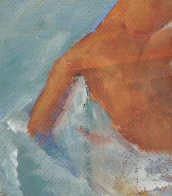

Sergey Yurievich Sudeikin (Russian: Сергей Юрьевич Судейкин), also known as Serge Soudeikine, was a Russian artist and set-designer renowned for his vivid contributions to the world of art and theater. Born on March 19, 1882, in Smolensk, Russia, and passing away on August 12, 1946, in Nyack, New York, Sudeikin's career was a testament to his versatile talent and innovative vision. He was closely associated with prestigious institutions such as the Ballets Russes and the Metropolitan Opera, showcasing his unique ability to blend artistic and theatrical design.
Sudeikin's journey in the arts began at the Moscow School of Painting, Sculpture and Architecture, where he was notably banned for his bold, "obscene drawings". This rebellious start led him to join the Mir Iskusstva (World of Art) movement, solidifying his place among Russia's avant-garde artists. His circle included significant figures like poet Mikhail Kuzmin and impresario Serge Diaghilev, highlighting his integral role in Russia's cultural scene before emigrating to the West.
Among Sudeikin's notable works are his set and costume designs for Diaghilev's production of "La tragédie de Salomé" and his collaboration on "The Rite of Spring". After moving to the United States, he continued to leave his mark on the theater world, with works like the set design for the original Broadway production of "Porgy and Bess". Sudeikin's style is recognized for its theatricality, vivid color use, and often incorporated themes of irony and tragedy, deeply influencing the visual arts and theater design of the 20th century.
His artwork, including famous pieces like "Carousel", "Venetian masquerade", and "Portrait of Nina Shik", can be found in galleries and private collections worldwide, highlighting his enduring appeal. Despite facing challenges in gaining widespread recognition during his lifetime, Sudeikin's contributions to art and theater have solidified his legacy as a pioneering artist and designer.
Collectors and experts in art and antiques continue to celebrate Sergey Yurievich Sudeikin's work for its innovative approach and historical significance. To stay updated on sales and auction events related to Sudeikin's work, signing up for updates is highly recommended. This ensures that enthusiasts and collectors alike do not miss out on the opportunity to own a piece of this remarkable artist's legacy.


Sergey Yurievich Sudeikin (Russian: Сергей Юрьевич Судейкин), also known as Serge Soudeikine, was a Russian artist and set-designer renowned for his vivid contributions to the world of art and theater. Born on March 19, 1882, in Smolensk, Russia, and passing away on August 12, 1946, in Nyack, New York, Sudeikin's career was a testament to his versatile talent and innovative vision. He was closely associated with prestigious institutions such as the Ballets Russes and the Metropolitan Opera, showcasing his unique ability to blend artistic and theatrical design.
Sudeikin's journey in the arts began at the Moscow School of Painting, Sculpture and Architecture, where he was notably banned for his bold, "obscene drawings". This rebellious start led him to join the Mir Iskusstva (World of Art) movement, solidifying his place among Russia's avant-garde artists. His circle included significant figures like poet Mikhail Kuzmin and impresario Serge Diaghilev, highlighting his integral role in Russia's cultural scene before emigrating to the West.
Among Sudeikin's notable works are his set and costume designs for Diaghilev's production of "La tragédie de Salomé" and his collaboration on "The Rite of Spring". After moving to the United States, he continued to leave his mark on the theater world, with works like the set design for the original Broadway production of "Porgy and Bess". Sudeikin's style is recognized for its theatricality, vivid color use, and often incorporated themes of irony and tragedy, deeply influencing the visual arts and theater design of the 20th century.
His artwork, including famous pieces like "Carousel", "Venetian masquerade", and "Portrait of Nina Shik", can be found in galleries and private collections worldwide, highlighting his enduring appeal. Despite facing challenges in gaining widespread recognition during his lifetime, Sudeikin's contributions to art and theater have solidified his legacy as a pioneering artist and designer.
Collectors and experts in art and antiques continue to celebrate Sergey Yurievich Sudeikin's work for its innovative approach and historical significance. To stay updated on sales and auction events related to Sudeikin's work, signing up for updates is highly recommended. This ensures that enthusiasts and collectors alike do not miss out on the opportunity to own a piece of this remarkable artist's legacy.


Sergey Yurievich Sudeikin (Russian: Сергей Юрьевич Судейкин), also known as Serge Soudeikine, was a Russian artist and set-designer renowned for his vivid contributions to the world of art and theater. Born on March 19, 1882, in Smolensk, Russia, and passing away on August 12, 1946, in Nyack, New York, Sudeikin's career was a testament to his versatile talent and innovative vision. He was closely associated with prestigious institutions such as the Ballets Russes and the Metropolitan Opera, showcasing his unique ability to blend artistic and theatrical design.
Sudeikin's journey in the arts began at the Moscow School of Painting, Sculpture and Architecture, where he was notably banned for his bold, "obscene drawings". This rebellious start led him to join the Mir Iskusstva (World of Art) movement, solidifying his place among Russia's avant-garde artists. His circle included significant figures like poet Mikhail Kuzmin and impresario Serge Diaghilev, highlighting his integral role in Russia's cultural scene before emigrating to the West.
Among Sudeikin's notable works are his set and costume designs for Diaghilev's production of "La tragédie de Salomé" and his collaboration on "The Rite of Spring". After moving to the United States, he continued to leave his mark on the theater world, with works like the set design for the original Broadway production of "Porgy and Bess". Sudeikin's style is recognized for its theatricality, vivid color use, and often incorporated themes of irony and tragedy, deeply influencing the visual arts and theater design of the 20th century.
His artwork, including famous pieces like "Carousel", "Venetian masquerade", and "Portrait of Nina Shik", can be found in galleries and private collections worldwide, highlighting his enduring appeal. Despite facing challenges in gaining widespread recognition during his lifetime, Sudeikin's contributions to art and theater have solidified his legacy as a pioneering artist and designer.
Collectors and experts in art and antiques continue to celebrate Sergey Yurievich Sudeikin's work for its innovative approach and historical significance. To stay updated on sales and auction events related to Sudeikin's work, signing up for updates is highly recommended. This ensures that enthusiasts and collectors alike do not miss out on the opportunity to own a piece of this remarkable artist's legacy.


Sergey Yurievich Sudeikin (Russian: Сергей Юрьевич Судейкин), also known as Serge Soudeikine, was a Russian artist and set-designer renowned for his vivid contributions to the world of art and theater. Born on March 19, 1882, in Smolensk, Russia, and passing away on August 12, 1946, in Nyack, New York, Sudeikin's career was a testament to his versatile talent and innovative vision. He was closely associated with prestigious institutions such as the Ballets Russes and the Metropolitan Opera, showcasing his unique ability to blend artistic and theatrical design.
Sudeikin's journey in the arts began at the Moscow School of Painting, Sculpture and Architecture, where he was notably banned for his bold, "obscene drawings". This rebellious start led him to join the Mir Iskusstva (World of Art) movement, solidifying his place among Russia's avant-garde artists. His circle included significant figures like poet Mikhail Kuzmin and impresario Serge Diaghilev, highlighting his integral role in Russia's cultural scene before emigrating to the West.
Among Sudeikin's notable works are his set and costume designs for Diaghilev's production of "La tragédie de Salomé" and his collaboration on "The Rite of Spring". After moving to the United States, he continued to leave his mark on the theater world, with works like the set design for the original Broadway production of "Porgy and Bess". Sudeikin's style is recognized for its theatricality, vivid color use, and often incorporated themes of irony and tragedy, deeply influencing the visual arts and theater design of the 20th century.
His artwork, including famous pieces like "Carousel", "Venetian masquerade", and "Portrait of Nina Shik", can be found in galleries and private collections worldwide, highlighting his enduring appeal. Despite facing challenges in gaining widespread recognition during his lifetime, Sudeikin's contributions to art and theater have solidified his legacy as a pioneering artist and designer.
Collectors and experts in art and antiques continue to celebrate Sergey Yurievich Sudeikin's work for its innovative approach and historical significance. To stay updated on sales and auction events related to Sudeikin's work, signing up for updates is highly recommended. This ensures that enthusiasts and collectors alike do not miss out on the opportunity to own a piece of this remarkable artist's legacy.
